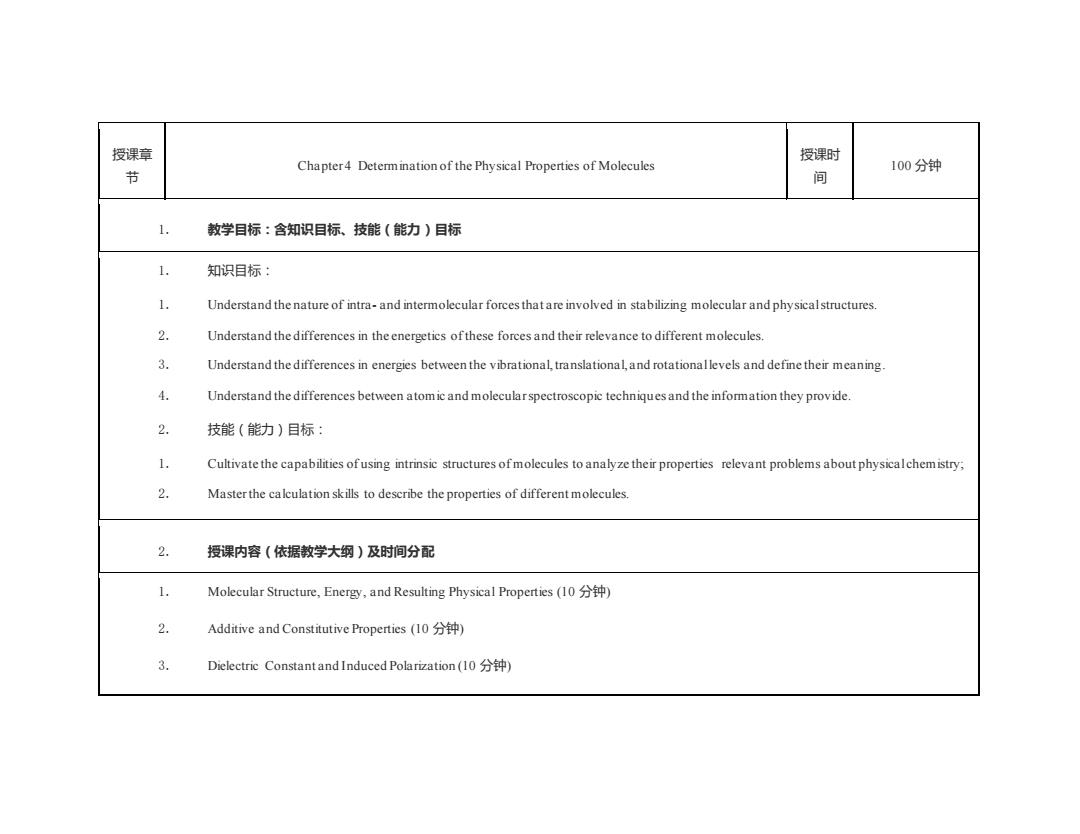
授课章 授课时 Chapter4 Determination of the Physical Properties of Molecules 节 间 100分钟 教学目标:含知识目标、技能(能力)目标 1. 知识目标: Understand the nature of intra-and intermolecular forces that are involved in stabilizing molecular and physicalstructures. 2. Understand the differences in the energetics ofthese forces and their relevance to different molecules. 3 Understand the differences in energies between the vibrational,translational,and rotationallevels and define their meaning. Understand the differences between atomic and molecularspectroscopic techniques and the information they provide. 2. 技能(能力)目标: 1. Cultivate the capabilities ofusing intrinsic structures of molecules to analyze their properties relevant problems about physicalchemistry; 2. Master the calculation skills to describe the properties of different molecules. 2. 授课内容(依据教学大纲)及时间分配 1. Molecular Structure,Energy,and Resulting Physical Properties(10) 2. Additive and Constitutive Properties(I0分钟) 3. Dielectric Constant and Induced Polarization(10)
授课章 节 Chapter 4 Determination of the Physical Properties of Molecules 授课时 间 100 分钟 1. 教学目标:含知识目标、技能(能力)目标 1. 知识目标: 1. Understand the nature of intra - and intermolecular forces that are involved in stabilizing molecular and physical structures. 2. Understand the differences in the energetics of these forces and their relevance to different molecules. 3. Understand the differences in energies between the vibrational, translational, and rotational levels and define their meaning. 4. Understand the differences between atomic and molecular spectroscopic techniques and the information they provide. 2. 技能(能力)目标: 1. Cultivate the capabilities of using intrinsic structures of molecules to analyze their properties relevant problems about physical chemistry; 2. Master the calculation skills to describe the properties of different molecules. 2. 授课内容(依据教学大纲)及时间分配 1. Molecular Structure, Energy, and Resulting Physical Properties (10 分钟) 2. Additive and Constitutive Properties (10 分钟) 3. Dielectric Constant and Induced Polarization (10 分钟)
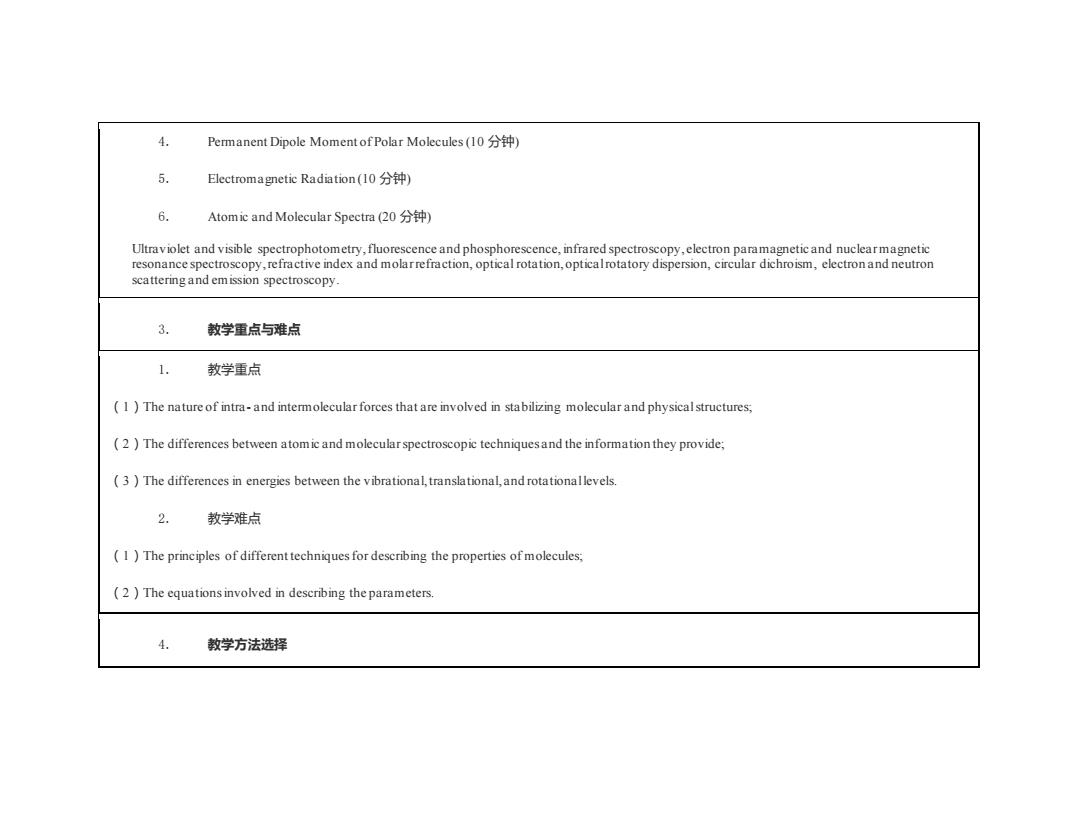
4. Permanent Dipole Moment of Polar Molecules(10) 5. Electromagnetic Radiation(I0分钟) 6. Atomic and Molecular Spectra(20分钟) Ultraviolet and visible spectrophotometry,fluorescence and phosphorescence,infrared spectroscopy,electron paramagnetic and nuclearmagnetic resonance spectroscopy,refractive index and molarrefraction,optical rotation,opticalrotatory dispersion,circular dichroism,electron and neutron scattering and emission spectroscopy. 3. 教学重点与难点 1. 教学重点 (I )The nature of intra-and intermolecular forces that are involved in stabilizing molecular and physicalstructures, (2 )The differences between atomic and molecularspectroscopic techniquesand the information they provide; (3 )The differences in energies between the vibrational,translational,and rotationallevels. 2. 教学难点 (I )The principles of different techniques for describing the properties of molecules; (2 )The equationsinvolved in describing the parameters. 4. 教学方法选择
4. Permanent Dipole Moment of Polar Molecules (10 分钟) 5. Electromagnetic Radiation (10 分钟) 6. Atomic and Molecular Spectra (20 分钟) Ultraviolet and visible spectrophotometry, fluorescence and phosphorescence, infrared spectroscopy, electron paramagnetic and nuclear magnetic resonance spectroscopy, refractive index and molar refraction, optical rotation, optical rotatory dispersion, circular dichroism, electron and neutron scattering and emission spectroscopy. 3. 教学重点与难点 1. 教学重点 (1)The nature of intra - and intermolecular forces that are involved in stabilizing molecular and physical structures; (2)The differences between atomic and molecular spectroscopic techniques and the information they provide; (3)The differences in energies between the vibrational, translational, and rotational levels. 2. 教学难点 (1)The principles of different techniques for describing the properties of molecules; (2)The equations involved in describing the parameters. 4. 教学方法选择
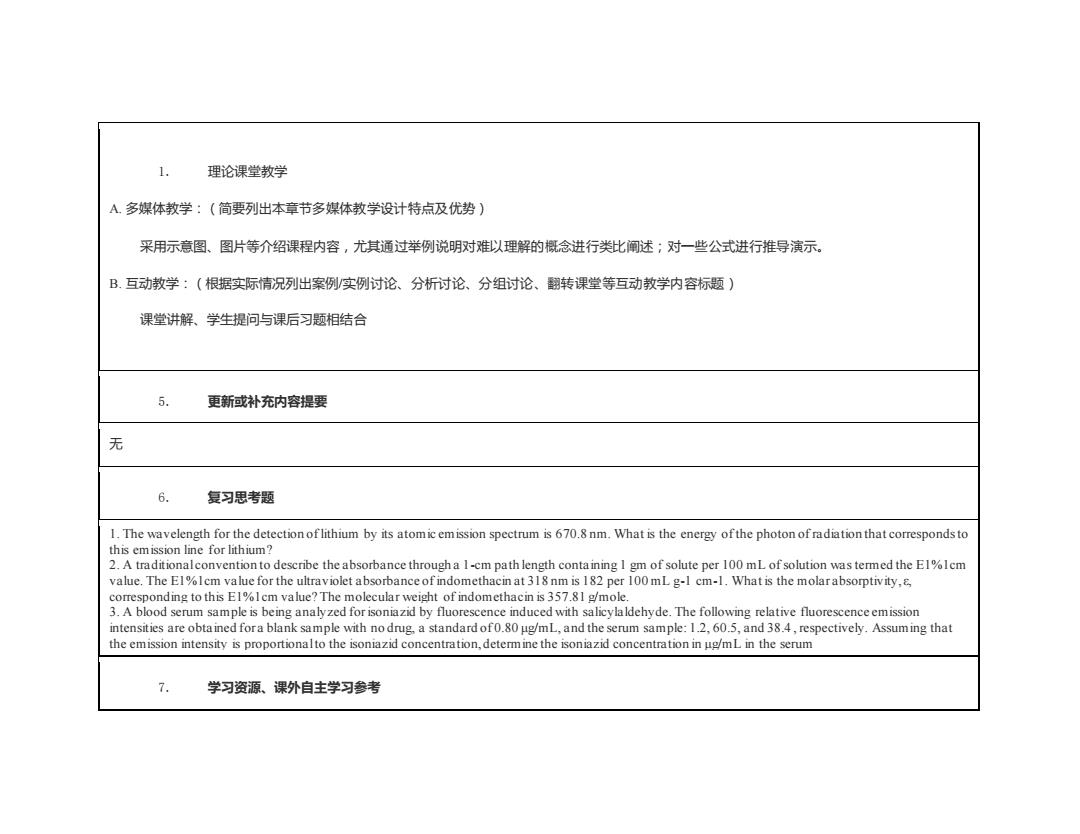
1. 理论课堂教学 A.多媒体教学:(简要列出本章节多媒体教学设计特点及优势) 采用示意图、图片等介绍课程内容,尤其通过举例说明对难以理解的概念进行类比阐述:对一些公式进行推导演示。 B.互动教学:(根据实际情况列出案例/实例讨论、分析讨论、分组讨论、翻转课堂等互动教学内容标题) 课堂讲解、学生提问与课后习题相结合 5. 更新或补充内容提要 无 6. 复习思考题 1.The wavelength for the detection of lithium by its atomic emission spectrum is 670.8 nm.What is the energy ofthe photon ofradiation that correspondsto this emission line for lithium? 2.A traditionalconvention to describe the absorbance through a I-cm path length containing I gm of solute per 100 mL of solution was termed the El%lcm value.The El%lcm value for the ultraviolet absorbance of indomethacin at 318 nm is 182 per 100 mL g-1 cm-1.What is the molarabsorptivity, corresponding to this El%1cm value?The molecular weight of indomethacin is 357.81 g/mole. 3.A blood serum sample is being analyzed for isoniazid by fluorescence induced with salicylaldehyde.The following relative fluorescence emission intensities are obtained fora blank sample with no drug,a standard of0.80 ug/mL,and the serum sample:1.2,60.5,and 38.4,respectively.Assuming that the emission intensity is proportionalto the isoniazid concentration,determine the isoniazid concentration in ug/mL in the serum 7. 学习资源、课外自主学习参考
1. 理论课堂教学 A. 多媒体教学:(简要列出本章节多媒体教学设计特点及优势) 采用示意图、图片等介绍课程内容,尤其通过举例说明对难以理解的概念进行类比阐述;对一些公式进行推导演示。 B. 互动教学:(根据实际情况列出案例/实例讨论、分析讨论、分组讨论、翻转课堂等互动教学内容标题) 课堂讲解、学生提问与课后习题相结合 5. 更新或补充内容提要 无 6. 复习思考题 1. The wavelength for the detection of lithium by its atomic emission spectrum is 670.8 nm. What is the energy of the photon of radiation that corresponds to this emission line for lithium? 2. A traditional convention to describe the absorbance through a 1-cm path length containing 1 gm of solute per 100 mL of solution was termed the E1%1cm value. The E1%1cm value for the ultraviolet absorbance of indomethacin at 318 nm is 182 per 100 mL g-1 cm-1. What is the molar absorptivity, ε, corresponding to this E1%1cm value? The molecular weight of indomethacin is 357.81 g/mole. 3. A blood serum sample is being analyzed for isoniazid by fluorescence induced with salicylaldehyde. The following relative fluorescence emission intensities are obtained for a blank sample with no drug, a standard of 0.80 μg/mL, and the serum sample: 1.2, 60.5, and 38.4 , respectively. Assuming that the emission intensity is proportional to the isoniazid concentration, determine the isoniazid concentration in μg/mL in the serum 7. 学习资源、课外自主学习参考
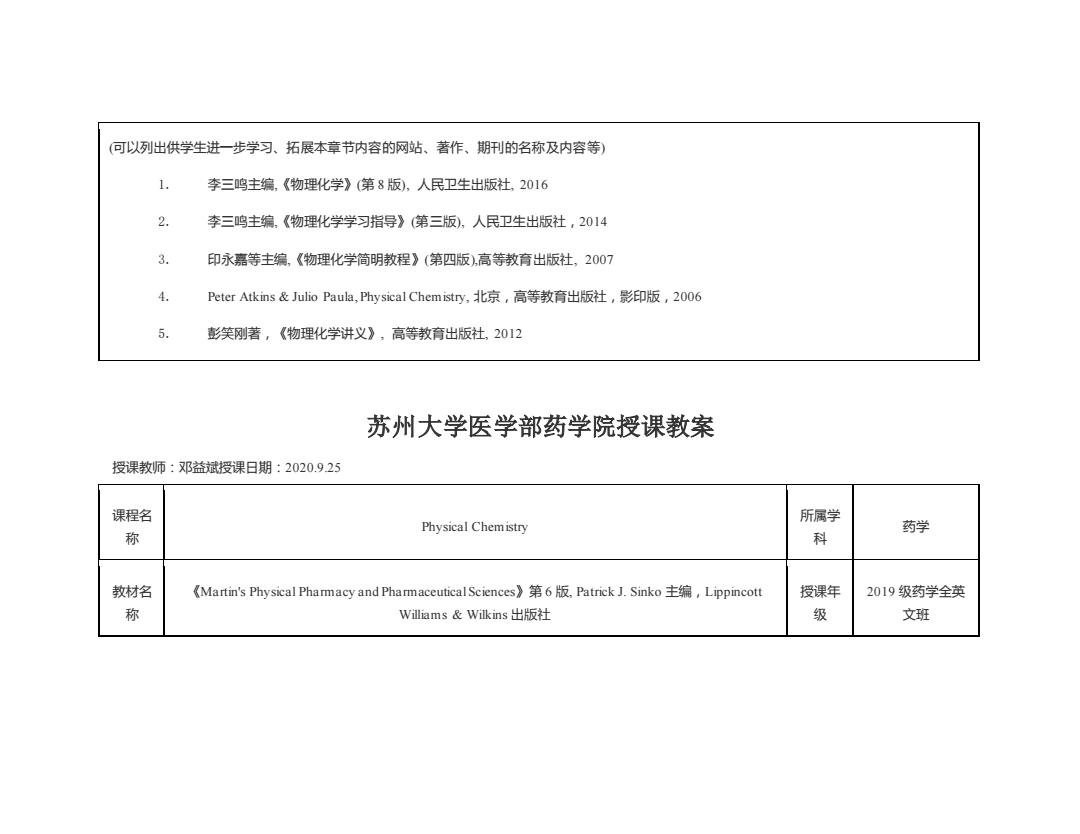
可以列出供学生进一步学习、拓展本章节内容的网站、著作、期刊的名称及内容等) 李三鸣主编,《物理化学》(第8版),人民卫生出版社,2016 2. 李三鸣主编,《物理化学学习指导》(第三版),人民卫生出版社,2014 3. 印永嘉等主编,《物理化学简明教程》(第四版),高等教育出版社,2007 4. Peter Atkins&Julio Paula,Physical Chemistry,北京,高等教育出版社,影印版,2006 5. 彭笑刚著,《物理化学讲义》,高等教育出版社,2012 苏州大学医学部药学院授课教案 授课教师:邓益斌授课日期:2020.925 课程名 所属学 Physical Chemistry 称 科 药学 教材名 《Martin's Physical Pharmacy and Pharmaceutical Sciences》第6版,Patrick J.Sinko主编,Lippincott 授课年 2019级药学全英 称 Williams&w冰ins出版社 级 文班
(可以列出供学生进一步学习、拓展本章节内容的网站、著作、期刊的名称及内容等) 1. 李三鸣主编,《物理化学》(第 8 版), 人民卫生出版社, 2016 2. 李三鸣主编,《物理化学学习指导》(第三版), 人民卫生出版社,2014 3. 印永嘉等主编,《物理化学简明教程》(第四版),高等教育出版社, 2007 4. Peter Atkins & Julio Paula, Physical Chemistry, 北京,高等教育出版社,影印版,2006 5. 彭笑刚著,《物理化学讲义》, 高等教育出版社, 2012 苏州大学医学部药学院授课教案 授课教师:邓益斌授课日期:2020.9.25 课程名 称 Physical Chemistry 所属学 科 药学 教材名 称 《Martin's Physical Pharmacy and Pharmaceutical Sciences》第 6 版, Patrick J. Sinko 主编,Lippincott Williams & Wilkins 出版社 授课年 级 2019 级药学全英 文班
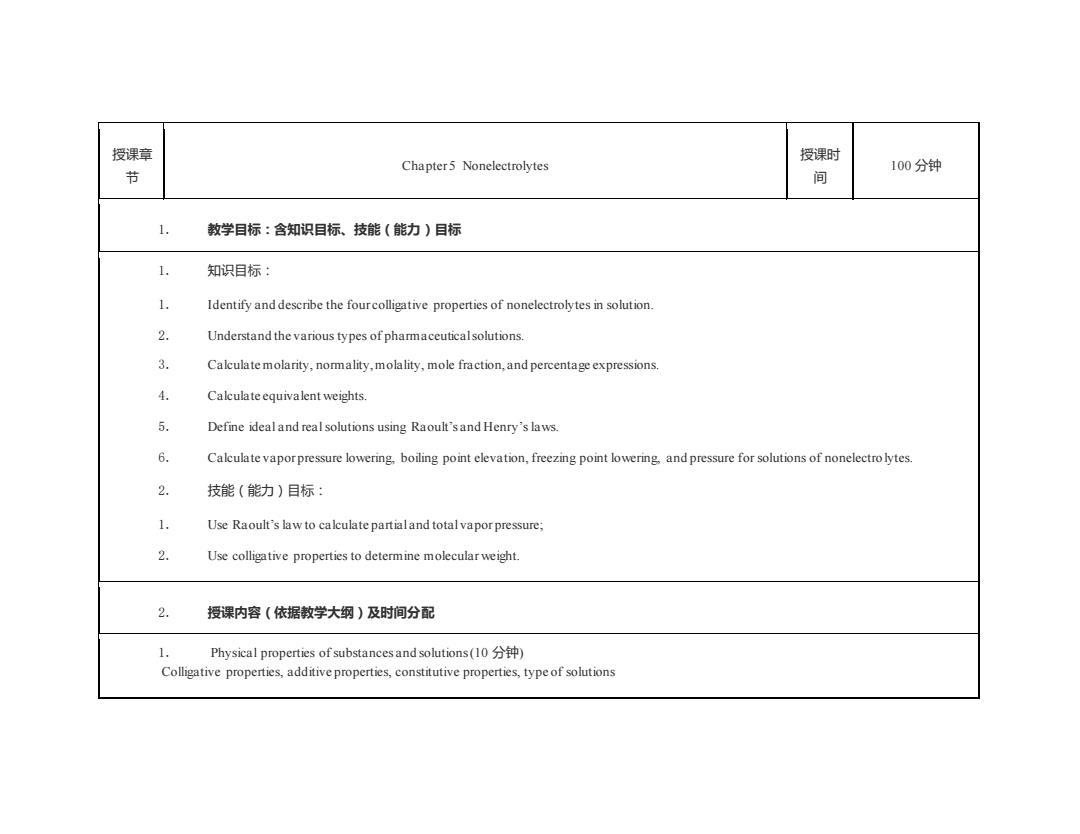
授课章 授课时 Chapter 5 Nonelectrolytes 100分钟 节 间 1. 教学目标:含知识目标、技能(能力)目标 1. 知识目标: Identify and describe the fourcolligative properties of nonelectrolytes in solution. 2. Understand the various types of pharmaceuticalsolutions. 3. Calculate molarity,nommality,molality,mole fraction,and percentage expressions. Calculate equivalent weights. 分 Define ideal and real solutions using Raoult's and Henry's laws. 6. Calculate vaporpressure lowering.boiling point elevation,freezing point lowering,and pressure for solutions of nonelectro lytes. 2. 技能(能力)目标: 1. Use Raoult's law to calculate partialand total vapor pressure; 2. Use colligative properties to determine molecular weight. 2. 授课内容(依据教学大纲)及时间分配 1. Physical properties of substances and solutions(10) Colligative properties,additive properties,constitutive properties,type of solutions
授课章 节 Chapter 5 Nonelectrolytes 授课时 间 100 分钟 1. 教学目标:含知识目标、技能(能力)目标 1. 知识目标: 1. Identify and describe the four colligative properties of nonelectrolytes in solution. 2. Understand the various types of pharmaceutical solutions. 3. Calculate molarity, normality, molality, mole fraction, and percentage expressions. 4. Calculate equivalent weights. 5. Define ideal and real solutions using Raoult’s and Henry’s laws. 6. Calculate vapor pressure lowering, boiling point elevation, freezing point lowering, and pressure for solutions of nonelectro lytes. 2. 技能(能力)目标: 1. Use Raoult’s law to calculate partial and total vapor pressure; 2. Use colligative properties to determine molecular weight. 2. 授课内容(依据教学大纲)及时间分配 1. Physical properties of substances and solutions (10 分钟) Colligative properties, additive properties, constitutive properties, type of solutions